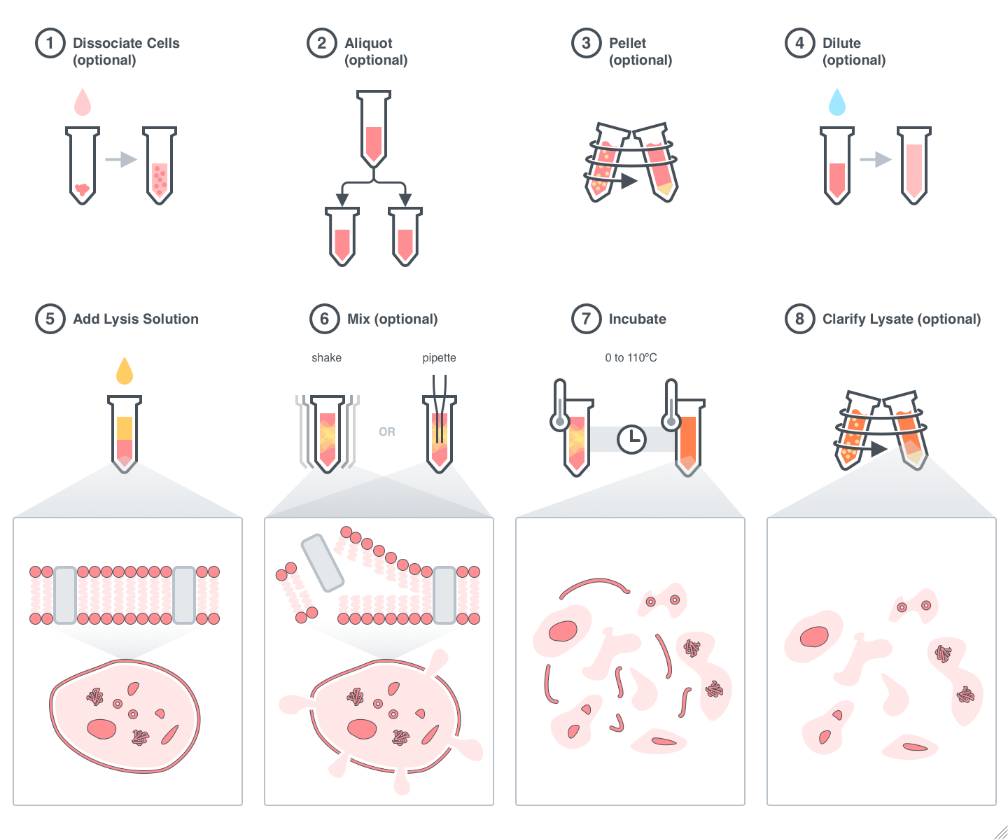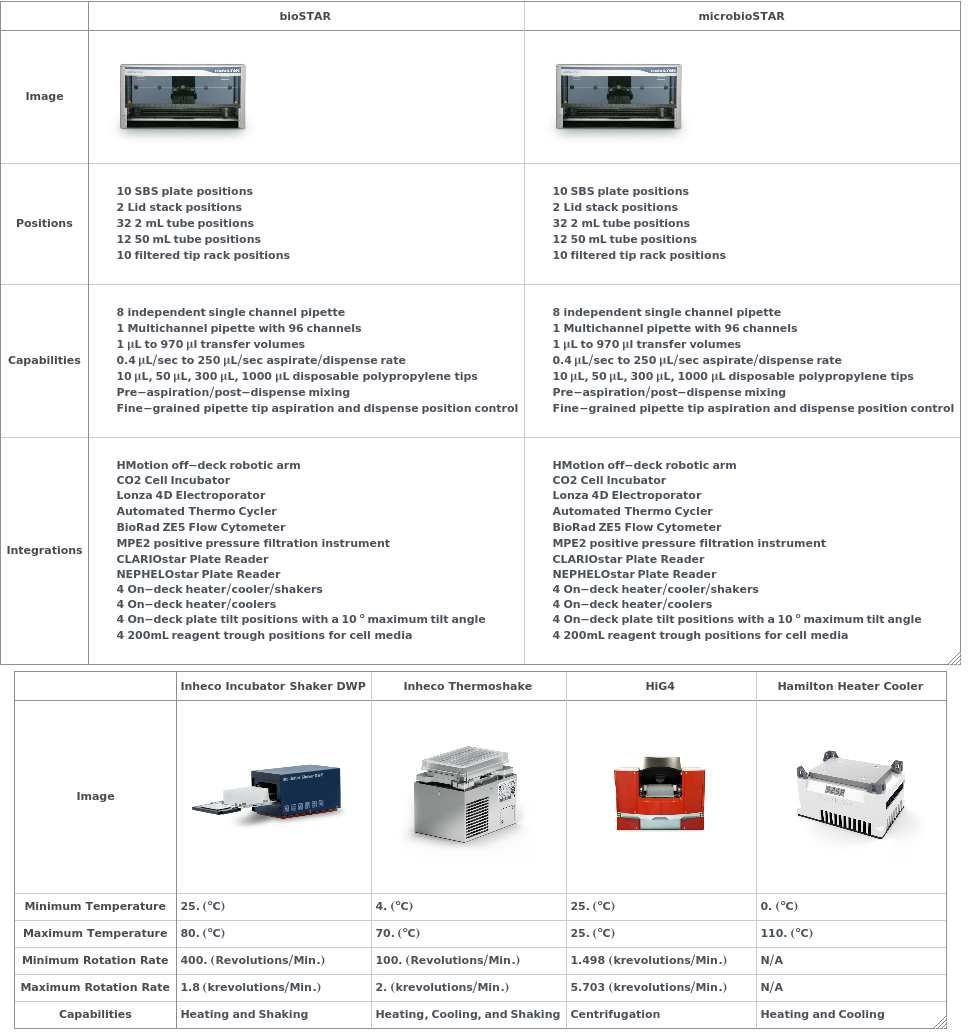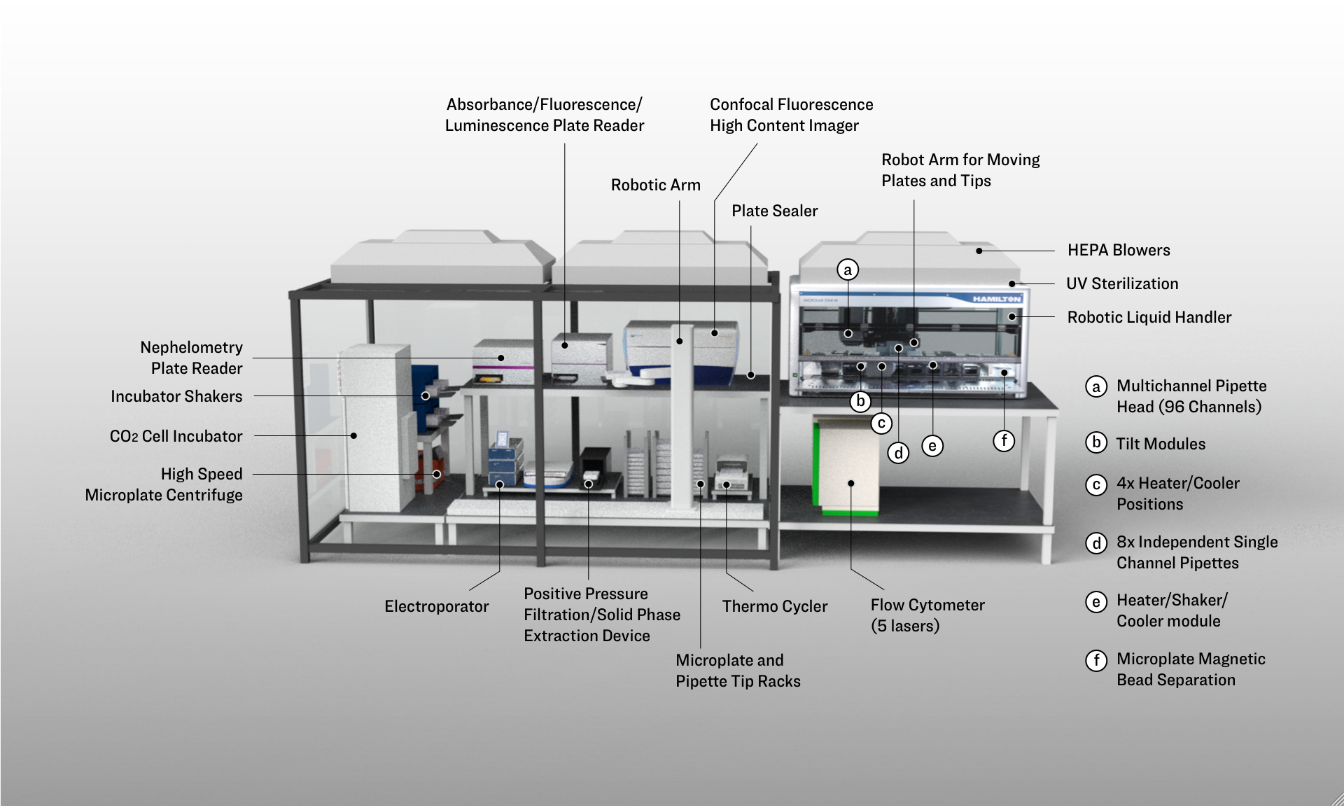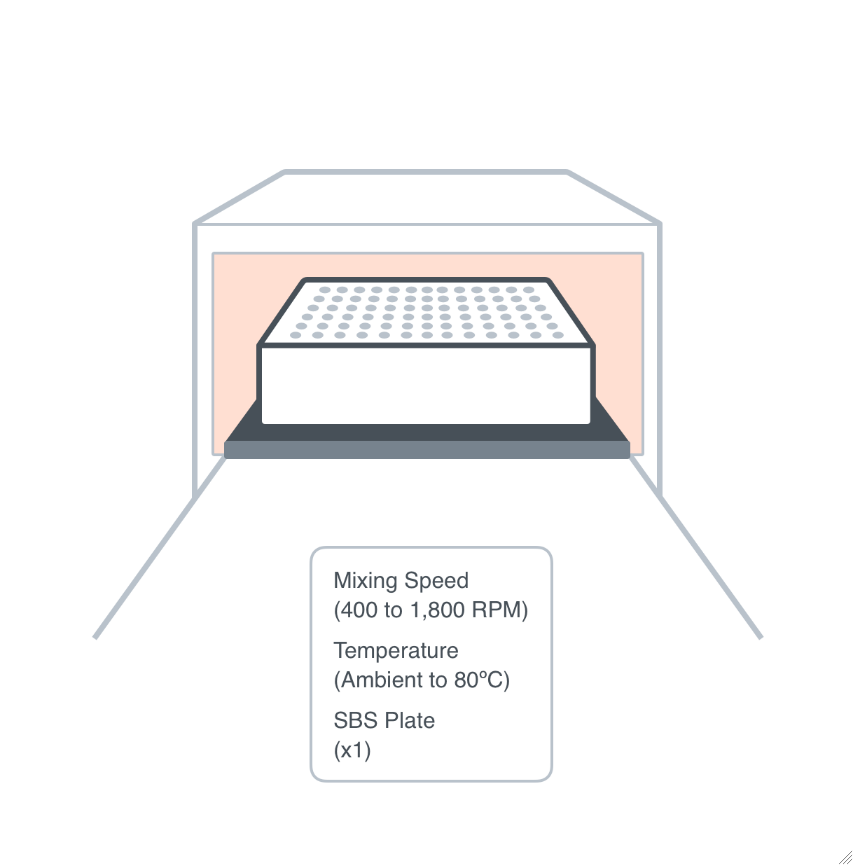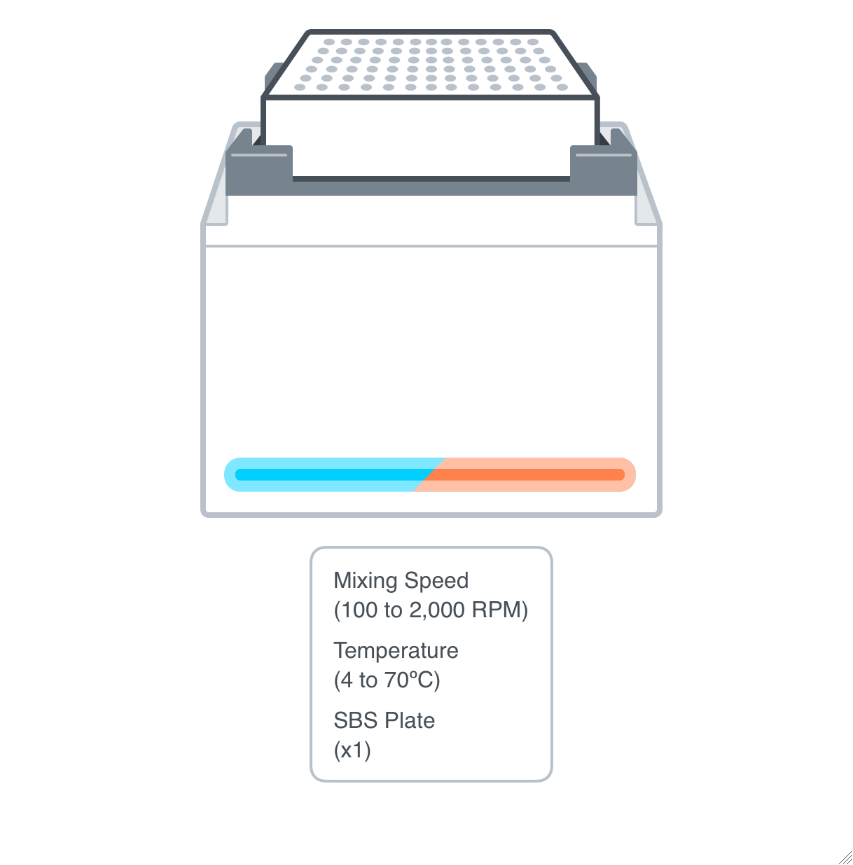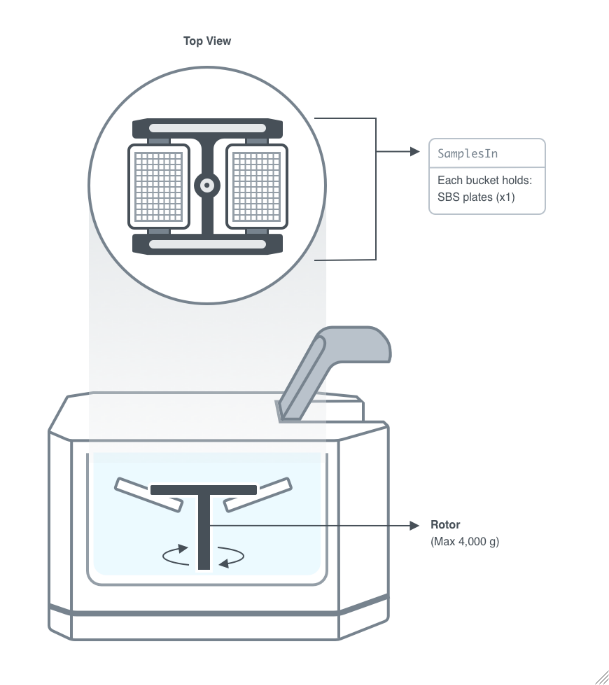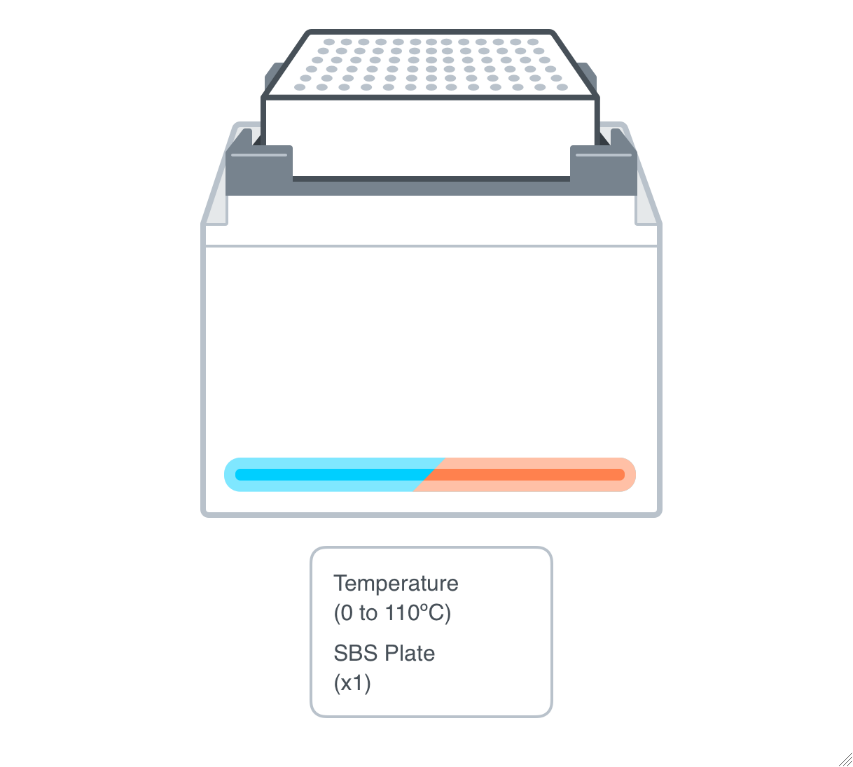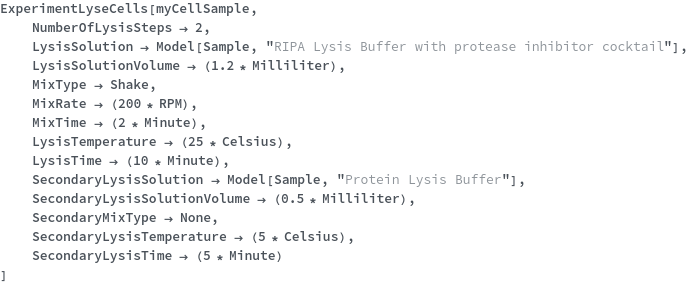General
Method
The set of reagents and recommended operating conditions which are used to lyse the cell sample and to perform subsequent extraction unit operations. Custom indicates that all reagents and conditions are individually selected by the user. Oftentimes, these can come from kit manufacturer recommendations.
Pattern Description: An object of type or subtype Object[Method, LyseCells], Object[Method, Extraction], or Object[Method, Harvest] or Custom.
Programmatic Pattern: Custom | ObjectP[{Object[Method, LyseCells], Object[Method, Extraction], Object[Method, Harvest]}]
Index Matches to: experiment samples
CellType
The taxon of the organism or cell line from which the cell sample originates. Options include Bacterial, Mammalian, Insect, Plant, and Yeast.
Default Calculation: Automatically set to the CellType field of the input sample. If the CellType field of the input sample is Unspecified, automatically set to the majority cell type of the input sample based on its composition.
Pattern Description: Bacterial, Mammalian, Yeast, Plant, Insect, Fungal, or Microbial or Null.
Programmatic Pattern: ((Null | CellTypeP) | Automatic) | Null
Index Matches to: experiment samples
CultureAdhesion
Indicates how the input cell sample physically interacts with its container. Options include Adherent and Suspension (including any microbial liquid media).
Default Calculation: Automatically set to the CultureAdhesion field of the input samples.
Pattern Description: Adherent, Suspension, or SolidMedia or Null.
Programmatic Pattern: ((Null | CultureAdhesionP) | Automatic) | Null
Index Matches to: experiment samples
TargetCellularComponent
The class of biomolecule whose purification is desired following lysis of the cell sample and any subsequent extraction operations. Options include CytosolicProtein, PlasmaMembraneProtein, NuclearProtein, SecretoryProtein, TotalProtein, RNA, GenomicDNA, PlasmidDNA, Organelle, Virus and Unspecified.
Pattern Description: {CytosolicProtein, PlasmaMembraneProtein, NuclearProtein, SecretoryProtein, TotalProtein, RNA, GenomicDNA, PlasmidDNA, Organelle, Virus} or Unspecified or Null.
Programmatic Pattern: ((Null | (CellularComponentP | Unspecified)) | Automatic) | Null
Index Matches to: experiment samples
NumberOfLysisSteps
The number of times that the cell sample is subjected to a unique set of conditions for disruption of the cell membranes. These conditions include the LysisSolution, LysisSolutionVolume, MixType, MixRate, NumberOfMixes, MixVolume, MixTemperature, MixInstrument, LysisTime, LysisTemperature, and IncubationInstrument.
Default Calculation: Automatically set to the number of lysis steps specified by the selected Method. If Method is set to Custom, automatically set to 2 if any options for a second lysis step are specified, or 3 if any options for a third lysis step are specified. Otherwise, automatically set to 1.
Pattern Description: 1, 2, or 3.
Programmatic Pattern: (1 | 2 | 3) | Automatic
Index Matches to: experiment samples
NumberOfReplicates
The number of wells into which the cell sample is aliquoted prior to the lysis experiment and subsequent unit operations, including extraction of cellular components such as nucleic acids, proteins, or organelles.
Pattern Description: Greater than or equal to 2 and less than or equal to 200 in increments of 1 or Null.
Programmatic Pattern: RangeP[2, 200, 1] | Null
Preparation
Indicates if this unit operation is carried out primarily robotically or manually. Manual unit operations are executed by a laboratory operator and robotic unit operations are executed by a liquid handling work cell.
Pattern Description: Robotic.
Programmatic Pattern: Robotic
RoboticInstrument
The robotic liquid handler used (along with integrated instrumentation for heating, mixing, and other functions) to manipulate the cell sample in order to extract and purify targeted cellular components.
Default Calculation: Automatically set to a robotic liquid handler compatible with the specified temperatures, mix types, and mix rates required by the extraction experiment, as well as the container and CellType of the sample. See the function MixDevices for integrated mixing instruments compatible with a given sample. See the function IncubationDevices for integrated heating instruments compatible with a given sample.
Pattern Description: An object of type or subtype Object[Instrument, LiquidHandler] or Model[Instrument, LiquidHandler]
Programmatic Pattern: ObjectP[{Object[Instrument, LiquidHandler], Model[Instrument, LiquidHandler]}] | Automatic
WorkCell
Indicates the work cell that this primitive will be run on if Preparation->Robotic.
Default Calculation: Automatically set to STAR if Preparation->Robotic.
Pattern Description: STAR, bioSTAR, or microbioSTAR or Null.
Programmatic Pattern: ((STAR | bioSTAR | microbioSTAR) | Automatic) | Null
Dissociation
Dissociate
Indicates if adherent cells in the input cell sample are dissociated from their container prior to cell lysis.
Default Calculation: Automatically set to True if CultureAdhesion is Adherent and Aliquot is True. If CultureAdhesion is set to Suspension, automatically set to False. If neither of these conditions are met, Dissociate is automatically set to False.
Pattern Description: True or False.
Programmatic Pattern: BooleanP | Automatic
Index Matches to: experiment samples
Aliquoting
TargetCellCount
The number of cells in the experiment prior to the addition of LysisSolution. Note that the TargetCellCount, if specified, is obtained by aliquoting rather than by cell culture.
Default Calculation: Automatically calculated from the composition of the cell sample and AliquotAmount if sufficient cell count or concentration data is available. If the cell count cannot be calculated from the available sample information, TargetCellCount is automatically set to Null.
Pattern Description: Greater than 0 Cells or Null.
Programmatic Pattern: (GreaterP[Quantity[0, IndependentUnit["Cells"]]] | Automatic) | Null
Index Matches to: experiment samples
TargetCellConcentration
The concentration of cells in the experiment prior to the addition of LysisSolution. Note that the TargetCellConcentration, if specified, is obtained by aliquoting and optional dilution rather than by cell culture.
Default Calculation: Automatically calculated from the composition of the cell sample, AliquotAmount, and any additional solution volumes added to the experiment if sufficient cell count or concentration data is available. If the cell concentration cannot be calculated from the available sample information, TargetCellConcentration is automatically set to Null.
Pattern Description: Greater than 0 Cells per milliliter or Null.
Programmatic Pattern: (GreaterP[Quantity[0, IndependentUnit["Cells"]]/Milliliter] | Automatic) | Null
Index Matches to: experiment samples
Pelleting
PreLysisPellet
Indicates if the cell sample is centrifuged to remove unwanted media prior to addition of LysisSolution.
Default Calculation: Automatically set to True if any of PreLysisPelletingIntensity, PreLysisPelletingTime, PreLysisSupernatantVolume, PreLysisSupernatantStorageCondition, or PreLysisSupernatantContainer are set. Otherwise, automatically set to True if and only if pelleting is necessary to obtain the specified TargetCellConcentration.
Pattern Description: True or False.
Programmatic Pattern: BooleanP | Automatic
Index Matches to: experiment samples
PreLysisPelletingCentrifuge
The centrifuge used to apply centrifugal force to the cell samples at PreLysisPelletingIntensity for PreLysisPelletingTime in order to remove unwanted media prior to addition of LysisSolution.
Default Calculation: Automatically set to Model[Instrument, Centrifuge, "HiG4"] if PreLysisPellet is True. Otherwise, automatically set to Null.
Pattern Description: An object of type or subtype Object[Instrument] or Model[Instrument] or Null.
Programmatic Pattern: (ObjectP[{Object[Instrument], Model[Instrument]}] | Automatic) | Null
Index Matches to: experiment samples
PreLysisPelletingIntensity
The rotational speed or force applied to the cell sample to facilitate separation of the cells from the media.
Default Calculation: Automatically set to the PreLysisPelletingIntensity specified by the selected Method. If Method is set to Custom and PreLysisPellet is True, automatically set to 2850 RPM for Yeast cells, 4030 RPM for Bacterial cells, and 1560 RPM for Mammalian Cells. If PreLysisPellet is False, PreLysisPelletingIntensity is automatically set to Null.
Pattern Description: Relative Centrifugal Force or Revolutions per Minute or Null.
Programmatic Pattern: ((RangeP[0*RPM, $MaxRoboticCentrifugeSpeed] | RangeP[0*GravitationalAcceleration, $MaxRoboticRelativeCentrifugalForce]) | Automatic) | Null
Index Matches to: experiment samples
PreLysisPelletingTime
The duration for which the cell sample is centrifuged at PreLysisPelletingIntensity to facilitate separation of the cells from the media.
Default Calculation: Automatically set to the PreLysisPelletingTime specified by the selected Method. If Method is set to Custom and PreLysisPellet is True, automatically set to 10 minutes.
Pattern Description: Greater than or equal to 0 minutes and less than or equal to 72 hours or Null.
Programmatic Pattern: (RangeP[0*Minute, $MaxExperimentTime] | Automatic) | Null
Index Matches to: experiment samples
PreLysisSupernatantVolume
The volume of the supernatant that is transferred to a new container after the cell sample is pelleted prior to optional dilution and addition of LysisSolution.
Default Calculation: Automatically set to 80% of the occupied volume of the container if PreLysisPellet is True. Otherwise, automatically set to Null.
Pattern Description: All or Volume or Null.
Programmatic Pattern: ((RangeP[0*Microliter, $MaxRoboticTransferVolume] | All) | Automatic) | Null
Index Matches to: experiment samples
PreLysisSupernatantStorageCondition
The set of parameters that define the temperature, safety, and other environmental conditions under which the supernatant isolated from the cell sample is stored upon completion of this protocol.
Default Calculation: Automatically set to Disposal if PreLysisPellet is True. Otherwise, automatically set to Null.
Pattern Description: Storage Object or Storage Type or Null.
Programmatic Pattern: (((SampleStorageTypeP | Disposal) | ObjectP[Model[StorageCondition]]) | Automatic) | Null
Index Matches to: experiment samples
PreLysisSupernatantContainer
The container into which the supernatant is transferred after the cell sample is pelleted by centrifugation and stored for future use.
Default Calculation: Automatically set to a Model[Container] with sufficient capacity for the volume of the supernatant using the PreferredContainer function if PreLysisPellet is True. If PreLysisSupernatantStorageCondition is set to Disposal for multiple samples, the supernatants corresponding to these samples are automatically combined into a common container for efficient disposal. If PreLysisPellet is False, automatically set to Null.
Pattern Description: Container or Container with Index or Container with Well or Container with Well and Index or Null.
Programmatic Pattern: (((ObjectP[{Object[Container], Model[Container]}] | _String) | {GreaterEqualP[1, 1], ObjectP[{Model[Container]}]} | {Alternatives @@ Flatten[AllWells[NumberOfWells -> 384]], ObjectP[{Model[Container]}]} | {Alternatives @@ Flatten[AllWells[NumberOfWells -> 384]], {GreaterEqualP[1, 1], ObjectP[{Model[Container]}]}}) | Automatic) | Null
Index Matches to: experiment samples
Dilution
PreLysisDilute
Indicates if the cell sample is diluted prior to cell lysis.
Default Calculation: Automatically set to True if one or both of PreLysisDiluent and PreLysisDilutionVolume is specified, or if dilution is required to obtain the specified TargetCellConcentration. Otherwise, automatically set to False.
Pattern Description: True or False.
Programmatic Pattern: BooleanP | Automatic
Index Matches to: experiment samples
PreLysisDiluent
The solution with which the cell sample is diluted prior to cell lysis.
Default Calculation: Automatically set to Model[Sample, StockSolution, "1x PBS from 10X stock"] if PreLysisDilute is set to True. Otherwise, automatically set to Null.
Pattern Description: An object of type or subtype Object[Sample] or Model[Sample] or a prepared sample or Null.
Programmatic Pattern: ((ObjectP[{Object[Sample], Model[Sample]}] | _String) | Automatic) | Null
Index Matches to: experiment samples
PreLysisDilutionVolume
The volume of PreLysisDiluent added to the cell sample (or AliqoutAmount, if a portion of the cell sample has been aliquoted to an AliquotContainer) prior to addition of LysisSolution.
Default Calculation: Automatically set to the volume necessary to obtain the TargetCellConcentration if PreLysisDilute is True and TargetCellConcentration is specified. If PreLysisDilute is True, TargetCellConcentration is unspecified, and AliquotContainer is specified, automatically set to 25% of the volume of AliquotContainer. If PreLysisDilute is True but neither of TargetCellConcentration or AliquotContainer are specified, PreLysisDilutionVolume is automatically set to 0 Microliter due to insufficient information to determine a reasonable dilution volume.
Pattern Description: Greater than or equal to 0 microliters and less than or equal to 200 milliliters or Null.
Programmatic Pattern: (RangeP[0*Microliter, $MaxRoboticTransferVolume] | Automatic) | Null
Index Matches to: experiment samples
Lysis Solution Addition
LysisSolution
The solution employed for disruption of cell membranes, including enzymes, detergents, and chaotropics.
Default Calculation: Automatically set to the LysisSolution specified by the selected Method. If Method is set to Custom, automatically set according to the combination of CellType and TargetCellularComponents. LysisSolution is set to Model[Sample, "TRIzol"], Model[Sample, "DNAzol"], and Model[Sample, StockSolution, "RIPA Lysis Buffer with protease inhibitor cocktail"] when the TargetCellularComponent is RNA, GenomicDNA, and PlasmidDNA, respectively. If the TargetCellularComponent is CytosolicProtein, PlasmaMembraneProtein, NuclearProtein, SecretoryProtein, TotalProtein, or Unspecified, the LysisSolution is automatically set to Model[Sample, StockSolution, "RIPA Lysis Buffer with protease inhibitor cocktail"] for Mammalian cells, Model[Sample, "B-PER Bacterial Protein Extraction Reagent"] for Bacterial cells, and Model[Sample, "Y-PER Yeast Protein Extraction Reagent"] for Yeast or Fungal cells.
Pattern Description: An object of type or subtype Object[Sample] or Model[Sample] or a prepared sample.
Programmatic Pattern: (ObjectP[{Object[Sample], Model[Sample]}] | _String) | Automatic
Index Matches to: experiment samples
LysisSolutionVolume
The volume of LysisSolution to be added to the cell sample. If Aliquot is True, the LysisSolution is added to the AliquotContainer. Otherwise, the LysisSolution is added to the container of the input cell sample.
Default Calculation: LysisSolutionVolume is automatically set to 50% of the unoccupied volume of the sample's container (prior to addition of any lysis solutions) divided by the NumberOfLysisSteps if Aliquot is False. If AliquotContainer is specified, automatically set to 50% of the unoccupied volume of AliquotContainer (prior to addition of any lysis solutions) divided by the NumberOfLysisSteps. If Aliquot is True but AliquotContainer is unspecified, LysisSolutionVolume is automatically set to nine times the AliquotAmount divided by the NumberOfLysisSteps.
Pattern Description: All or greater than or equal to 0 microliters and less than or equal to 200 milliliters.
Programmatic Pattern: (RangeP[0*Microliter, $MaxRoboticTransferVolume] | All) | Automatic
Index Matches to: experiment samples
SecondaryLysisSolution
The solution employed for disruption of cell membranes, including enzymes, detergents, and chaotropics in an optional second lysis step.
Default Calculation: Automatically set to the SecondaryLysisSolution specified by the selected Method. If Method is set to Custom and NumberOfLysisSteps is greater than 1, automatically set to the LysisSolution employed in the first lysis step.
Pattern Description: An object of type or subtype Object[Sample] or Model[Sample] or a prepared sample or Null.
Programmatic Pattern: ((ObjectP[{Object[Sample], Model[Sample]}] | _String) | Automatic) | Null
Index Matches to: experiment samples
SecondaryLysisSolutionVolume
The volume of SecondaryLysisSolution to be added to the cell sample in an optional second lysis step. If Aliquot is True, the SecondaryLysisSolution is added to the AliquotContainer. Otherwise, the SecondaryLysisSolution is added to the container of the input cell sample.
Default Calculation: Automatically set to Null if NumberOfLysisSteps is 1. If NumberOfLysisSteps is greater than 1, SecondaryLysisSolutionVolume is automatically set to 50% of the unoccupied volume of the sample's container (prior to addition of any lysis solutions) divided by the NumberOfLysisSteps if Aliquot is False. If AliquotContainer is specified, automatically set to 50% of the unoccupied volume of AliquotContainer (prior to addition of any lysis solutions) divided by the NumberOfLysisSteps. If Aliquot is True but AliquotContainer is unspecified, SecondaryLysisSolutionVolume is automatically set to nine times the AliquotAmount divided by the NumberOfLysisSteps.
Pattern Description: All or greater than or equal to 0 microliters and less than or equal to 200 milliliters or Null.
Programmatic Pattern: ((RangeP[0*Microliter, $MaxRoboticTransferVolume] | All) | Automatic) | Null
Index Matches to: experiment samples
TertiaryLysisSolution
The solution employed for disruption of cell membranes, including enzymes, detergents, and chaotropics in an optional third lysis step.
Default Calculation: Automatically set to the TertiaryLysisSolution specified by the selected Method. If Method is set to Custom and NumberOfLysisSteps is 3, automatically set to the SecondaryLysisSolution employed in the second lysis step.
Pattern Description: An object of type or subtype Object[Sample] or Model[Sample] or a prepared sample or Null.
Programmatic Pattern: ((ObjectP[{Object[Sample], Model[Sample]}] | _String) | Automatic) | Null
Index Matches to: experiment samples
TertiaryLysisSolutionVolume
The volume of TertiaryLysisSolution to be added to the cell sample in an optional third lysis step. If Aliquot is True, the TertiaryLysisSolution is added to the AliquotContainer. Otherwise, the TertiaryLysisSolution is added to the container of the input cell sample.
Default Calculation: Automatically set to Null if NumberOfLysisSteps is less than 3. If NumberOfLysisSteps is 3, TertiaryLysisSolutionVolume is automatically set to 50% of the unoccupied volume of the sample's container (prior to addition of any lysis solutions) divided by the NumberOfLysisSteps if Aliquot is False. If AliquotContainer is specified, automatically set to 50% of the unoccupied volume of AliquotContainer (prior to addition of any lysis solutions) divided by the NumberOfLysisSteps. If Aliquot is True but AliquotContainer is unspecified, TertiaryLysisSolutionVolume is automatically set to nine times the AliquotAmount divided by the NumberOfLysisSteps.
Pattern Description: All or greater than or equal to 0 microliters and less than or equal to 200 milliliters or Null.
Programmatic Pattern: ((RangeP[0*Microliter, $MaxRoboticTransferVolume] | All) | Automatic) | Null
Index Matches to: experiment samples
Mixing
MixType
The manner in which the sample is mixed following combination of cell sample and LysisSolution.
Default Calculation: Automatically set to the MixType specified by the selected Method. If Method is set to Custom and either of MixVolume and NumberOfMixes are specified, automatically set to Pipette. If Method is set to Custom and any of MixRate, MixTime, and MixInstrument are specified, automatically set to Shake. Otherwise, MixType is automatically set to Shake if mixing is to occur in a plate or Pipette if it is to occur in a tube.
Pattern Description: Shake, Pipette, or None.
Programmatic Pattern: (Shake | Pipette | None) | Automatic
Index Matches to: experiment samples
MixRate
The rate at which the sample is mixed by the selected MixType during the MixTime.
Default Calculation: Automatically set to the MixRate specified by the selected Method. If Method is set to Custom and MixType is set to Shake, automatically set to 200 RPM.
Pattern Description: Greater than or equal to 0 revolutions per minute and less than or equal to 3200 revolutions per minute or Null.
Programmatic Pattern: (RangeP[0*RPM, $MaxMixRate] | Automatic) | Null
Index Matches to: experiment samples
MixTime
The duration for which the sample is mixed by the selected MixType following combination of the cell sample and the LysisSolution.
Default Calculation: If MixType is set to Shake, automatically set to the MixTime specified by the selected Method. If Method is set to Custom and MixType is set to Shake, automatically set to 1 minute.
Pattern Description: Greater than or equal to 0 minutes and less than or equal to 72 hours or Null.
Programmatic Pattern: (RangeP[0*Minute, $MaxExperimentTime] | Automatic) | Null
Index Matches to: experiment samples
NumberOfMixes
The number of times that the sample is mixed by pipetting the MixVolume up and down following combination of the cell sample and the LysisSolution.
Default Calculation: If MixType is set to Pipette, automatically set to the NumberOfMixes specified by the selected Method. If Method is set to Custom and MixType is set to Pipette, automatically set to 10.
Pattern Description: Greater than or equal to 1 and less than or equal to 50 in increments of 1 or Null.
Programmatic Pattern: (RangeP[1, $MaxNumberOfMixes, 1] | Automatic) | Null
Index Matches to: experiment samples
MixVolume
The volume of the cell sample and LysisSolution displaced during each mix-by-pipette mix cycle.
Default Calculation: If MixType is set to Pipette, automatically set to the lesser of 970 microliters or 50% of the total solution volume within the container.
Pattern Description: Greater than or equal to 0 microliters and less than or equal to 970 microliters or Null.
Programmatic Pattern: (RangeP[0*Microliter, $MaxRoboticSingleTransferVolume] | Automatic) | Null
Index Matches to: experiment samples
MixTemperature
The temperature at which the instrument heating or cooling the cell sample is maintained during the MixTime, which occurs immediately before the LysisTime.
Default Calculation: Automatically set to the MixTemperature specified by the selected Method. If Method is set to Custom, automatically set to Ambient.
Pattern Description: Ambient or Temperature or Null.
Programmatic Pattern: ((RangeP[$MinIncubationTemperature, $MaxIncubationTemperature] | Ambient) | Automatic) | Null
Index Matches to: experiment samples
MixInstrument
The device used to mix the cell sample by shaking.
Default Calculation: Automatically set to an available shaking device compatible with the specified MixRate and MixTemperature if MixType is set to Shake. Otherwise, automatically set to Null.
Pattern Description: An object of type or subtype Object[Instrument] or Model[Instrument] or Null.
Programmatic Pattern: (ObjectP[{Object[Instrument], Model[Instrument]}] | Automatic) | Null
Index Matches to: experiment samples
SecondaryMixType
The manner in which the sample is mixed following combination of cell sample and SecondaryLysisSolution in an optional second lysis step.
Default Calculation: Automatically set to the SecondaryMixType specified by the selected Method. If Method is set to Custom and either of SecondaryMixVolume and SecondaryNumberOfMixes are specified, automatically set to Pipette. If Method is set to Custom and any of SecondaryMixRate, SecondaryMixTime, and SecondaryMixInstrument are specified, automatically set to Shake. Otherwise, SecondaryMixType is automatically set to Shake if mixing is to occur in a plate or Pipette if it is to occur in a tube.
Pattern Description: Shake, Pipette, or None or Null.
Programmatic Pattern: ((Shake | Pipette | None) | Automatic) | Null
Index Matches to: experiment samples
SecondaryMixRate
The rate at which the sample is mixed by the selected SecondaryMixType during the SecondaryMixTime in an optional second lysis step.
Default Calculation: Automatically set to the SecondaryMixRate specified by the selected Method. If Method is set to Custom, NumberOfLysisSteps is greater than 1, and SecondaryMixType is set to Shake, automatically set to 200 RPM.
Pattern Description: Greater than or equal to 0 revolutions per minute and less than or equal to 3200 revolutions per minute or Null.
Programmatic Pattern: (RangeP[0*RPM, $MaxMixRate] | Automatic) | Null
Index Matches to: experiment samples
SecondaryMixTime
The duration for which the sample is mixed by the selected SecondaryMixType following combination of the cell sample and the SecondaryLysisSolution in an optional second lysis step.
Default Calculation: If SecondaryMixType is set to Shake, automatically set to the SecondaryMixTime specified by the selected Method. If Method is set to Custom, NumberOfLysisSteps is greater than 1, and SecondaryMixType is set to Shake, automatically set to 1 minute.
Pattern Description: Greater than or equal to 0 minutes and less than or equal to 72 hours or Null.
Programmatic Pattern: (RangeP[0*Minute, $MaxExperimentTime] | Automatic) | Null
Index Matches to: experiment samples
SecondaryNumberOfMixes
The number of times that the sample is mixed by pipetting the SecondaryMixVolume up and down following combination of the cell sample and the SecondaryLysisSolution in an optional second lysis step.
Default Calculation: If SecondaryMixType is set to Pipette and NumberOfLysisSteps is greater than 1, automatically set to the SecondaryNumberOfMixes specified by the selected Method. If Method is set to Custom, NumberOfLysisSteps is greater than 1, and SecondaryMixType is set to Pipette, automatically set to 10.
Pattern Description: Greater than or equal to 1 and less than or equal to 50 in increments of 1 or Null.
Programmatic Pattern: (RangeP[1, $MaxNumberOfMixes, 1] | Automatic) | Null
Index Matches to: experiment samples
SecondaryMixVolume
The volume of the cell sample and SecondaryLysisSolution displaced during each mix-by-pipette mix cycle in an optional second lysis step.
Default Calculation: If SecondaryMixType is set to Pipette and NumberOfLysisSteps is greater than 1, automatically set to the lesser of 970 microliters or 50% of the total solution volume within the container.
Pattern Description: Greater than or equal to 0 microliters and less than or equal to 970 microliters or Null.
Programmatic Pattern: (RangeP[0*Microliter, $MaxRoboticSingleTransferVolume] | Automatic) | Null
Index Matches to: experiment samples
SecondaryMixTemperature
The temperature at which the instrument heating or cooling the cell sample is maintained during the SecondaryMixTime, which occurs immediately before the SecondaryLysisTime in an optional second lysis step.
Default Calculation: Automatically set to the SecondaryMixTemperature specified by the selected Method. If Method is set to Custom and NumberOfLysisSteps is greater than 1, automatically set to Ambient.
Pattern Description: Ambient or Temperature or Null.
Programmatic Pattern: ((RangeP[$MinIncubationTemperature, $MaxIncubationTemperature] | Ambient) | Automatic) | Null
Index Matches to: experiment samples
SecondaryMixInstrument
The device used to mix the cell sample by shaking in an optional second lysis step.
Default Calculation: Automatically set to an available shaking device compatible with the specified SecondaryMixRate and SecondaryMixTemperature if SecondaryMixType is set to Shake and NumberOfLysisSteps is greater than 1. Otherwise, automatically set to Null.
Pattern Description: An object of type or subtype Object[Instrument] or Model[Instrument] or Null.
Programmatic Pattern: (ObjectP[{Object[Instrument], Model[Instrument]}] | Automatic) | Null
Index Matches to: experiment samples
TertiaryMixType
The manner in which the sample is mixed following combination of cell sample and TertiaryLysisSolution in an optional third lysis step.
Default Calculation: Automatically set to the TertiaryMixType specified by the selected Method. If Method is set to Custom and either of TertiaryMixVolume and TertiaryNumberOfMixes are specified, automatically set to Pipette. If Method is set to Custom and any of TertiaryMixRate, TertiaryMixTime, and TertiaryMixInstrument are specified, automatically set to Shake. Otherwise, TertiaryMixType is automatically set to Shake if mixing is to occur in a plate or Pipette if it is to occur in a tube.
Pattern Description: Shake, Pipette, or None or Null.
Programmatic Pattern: ((Shake | Pipette | None) | Automatic) | Null
Index Matches to: experiment samples
TertiaryMixRate
The rate at which the sample is mixed by the selected TertiaryMixType during the TertiaryMixTime in an optional third lysis step.
Default Calculation: Automatically set to the TertiaryMixRate specified by the selected Method. If Method is set to Custom, NumberOfLysisSteps is 3, and TertiaryMixType is set to Shake, automatically set to 200 RPM.
Pattern Description: Greater than or equal to 0 revolutions per minute and less than or equal to 3200 revolutions per minute or Null.
Programmatic Pattern: (RangeP[0*RPM, $MaxMixRate] | Automatic) | Null
Index Matches to: experiment samples
TertiaryMixTime
The duration for which the sample is mixed by the selected TertiaryMixType following combination of the cell sample and the TertiaryLysisSolution in an optional third lysis step.
Default Calculation: If TertiaryMixType is set to Shake, automatically set to the TertiaryMixTime specified by the selected Method. If Method is set to Custom, NumberOfLysisSteps is 3, and TertiaryMixType is set to Shake, automatically set to 1 minute.
Pattern Description: Greater than or equal to 0 minutes and less than or equal to 72 hours or Null.
Programmatic Pattern: (RangeP[0*Minute, $MaxExperimentTime] | Automatic) | Null
Index Matches to: experiment samples
TertiaryNumberOfMixes
The number of times that the sample is mixed by pipetting the TertiaryMixVolume up and down following combination of the cell sample and the TertiaryLysisSolution in an optional third lysis step.
Default Calculation: If TertiaryMixType is set to Pipette and NumberOfLysisSteps is 3, automatically set to the TertiaryNumberOfMixes specified by the selected Method. If Method is set to Custom and TertiaryMixType is set to Pipette, automatically set to 10.
Pattern Description: Greater than or equal to 1 and less than or equal to 50 in increments of 1 or Null.
Programmatic Pattern: (RangeP[1, $MaxNumberOfMixes, 1] | Automatic) | Null
Index Matches to: experiment samples
TertiaryMixVolume
The volume of the cell sample and TertiaryLysisSolution displaced during each mix-by-pipette mix cycle in an optional third lysis step.
Default Calculation: If TertiaryMixType is set to Pipette and NumberOfLysisSteps is 3, automatically set to the TertiaryMixVolume specified by the selected Method. If Method is set to Custom and TertiaryMixType is set to Pipette, automatically set to the lesser of 970 microliters or 50% of the total solution volume within the container.
Pattern Description: Greater than or equal to 0 microliters and less than or equal to 970 microliters or Null.
Programmatic Pattern: (RangeP[0*Microliter, $MaxRoboticSingleTransferVolume] | Automatic) | Null
Index Matches to: experiment samples
TertiaryMixTemperature
The temperature at which the instrument heating or cooling the cell sample is maintained during the TertiaryMixTime, which occurs immediately before the TertiaryLysisTime in an optional third lysis step.
Default Calculation: Automatically set to the TertiaryMixTemperature specified by the selected Method. If Method is set to Custom, automatically set to Ambient.
Pattern Description: Ambient or Temperature or Null.
Programmatic Pattern: ((RangeP[$MinIncubationTemperature, $MaxIncubationTemperature] | Ambient) | Automatic) | Null
Index Matches to: experiment samples
TertiaryMixInstrument
The device used to mix the cell sample by shaking in an optional third lysis step.
Default Calculation: If NumberOfLysisSteps is 3 and TertiaryMixType is set to Shake, automatically set to an available shaking device compatible with the specified TertiaryMixRate and TertiaryMixTemperature.
Pattern Description: An object of type or subtype Object[Instrument] or Model[Instrument] or Null.
Programmatic Pattern: (ObjectP[{Object[Instrument], Model[Instrument]}] | Automatic) | Null
Index Matches to: experiment samples
Cell Lysis
LysisTime
The minimum duration for which the IncubationInstrument is maintained at the LysisTemperature to facilitate the disruption of cell membranes and release of cellular contents. The LysisTime occurs immediately after addition of LysisSolution and optional mixing.
Default Calculation: Automatically set to the LysisTime specified by the selected Method. If Method is set to Custon, automatically set to 15 Minute.
Pattern Description: Greater than or equal to 0 minutes and less than or equal to 72 hours.
Programmatic Pattern: RangeP[0*Minute, $MaxExperimentTime] | Automatic
Index Matches to: experiment samples
LysisTemperature
The temperature at which the IncubationInstrument is maintained during the LysisTime, following the mixing of the cell sample and LysisSolution.
Default Calculation: Automatically set to the LysisTemperature specified by the selected Method. If Method is set to Custom, automatically set to Ambient.
Pattern Description: Ambient or Temperature.
Programmatic Pattern: (RangeP[$MinIncubationTemperature, $MaxIncubationTemperature] | Ambient) | Automatic
Index Matches to: experiment samples
IncubationInstrument
The device used to cool or heat the cell sample to the LysisTemperature for the duration of the LysisTime.
Default Calculation: Automatically set to an integrated instrument compatible with the specified LysisTemperature.
Pattern Description: An object of type or subtype Object[Instrument] or Model[Instrument]
Programmatic Pattern: ObjectP[{Object[Instrument], Model[Instrument]}] | Automatic
Index Matches to: experiment samples
SecondaryLysisTime
The minimum duration for which the SecondaryIncubationInstrument is maintained at the SecondaryLysisTemperature to facilitate the disruption of cell membranes and release of cellular contents in an optional second lysis step. The SecondaryLysisTime occurs immediately after addition of SecondaryLysisSolution and optional mixing.
Default Calculation: Automatically set to the SecondaryLysisTime specified by the selected Method. If Method is set to Custom and NumberOfLysisSteps is greater than 1, automatically set to 15 minutes.
Pattern Description: Greater than or equal to 0 minutes and less than or equal to 72 hours or Null.
Programmatic Pattern: (RangeP[0*Minute, $MaxExperimentTime] | Automatic) | Null
Index Matches to: experiment samples
SecondaryLysisTemperature
The temperature at which the SecondaryIncubationInstrument is maintained during the SecondaryLysisTime, following the mixing of the cell sample and SecondaryLysisSolution in an optional second lysis step.
Default Calculation: Automatically set to the SecondaryLysisTemperature specified by the selected Method. If Method is set to Custom and NumberOfLysisSteps is greater than 1, automatically set to Ambient.
Pattern Description: Ambient or Temperature or Null.
Programmatic Pattern: ((RangeP[$MinIncubationTemperature, $MaxIncubationTemperature] | Ambient) | Automatic) | Null
Index Matches to: experiment samples
SecondaryIncubationInstrument
The device used to cool or heat the cell sample to the SecondaryLysisTemperature for the duration of the SecondaryLysisTime in an optional second lysis step.
Default Calculation: If NumberOfLysisSteps is greater than 1, automatically set to an integrated instrument compatible with the specified SecondaryLysisTemperature.
Pattern Description: An object of type or subtype Object[Instrument] or Model[Instrument] or Null.
Programmatic Pattern: (ObjectP[{Object[Instrument], Model[Instrument]}] | Automatic) | Null
Index Matches to: experiment samples
TertiaryLysisTime
The minimum duration for which the TertiaryIncubationInstrument is maintained at the TertiaryLysisTemperature to facilitate the disruption of cell membranes and release of cellular contents in an optional third lysis step. The TertiaryLysisTime occurs immediately after addition of TertiaryLysisSolution and optional mixing.
Default Calculation: Automatically set to the TertiaryLysisTime specified by the selected Method. If Method is set to Custom and NumberOfLysisSteps is 3, automatically set to 15 minutes.
Pattern Description: Greater than or equal to 0 minutes and less than or equal to 72 hours or Null.
Programmatic Pattern: (RangeP[0*Minute, $MaxExperimentTime] | Automatic) | Null
Index Matches to: experiment samples
TertiaryLysisTemperature
The temperature at which the TertiaryIncubationInstrument is maintained during the TertiaryLysisTime, following the mixing of the cell sample and TertiaryLysisSolution in an optional third lysis step.
Default Calculation: Automatically set to the TertiaryLysisTemperature specified by the selected Method. If Method is set to Custom and NumberOfLysisSteps is 3, automatically set to Ambient.
Pattern Description: Ambient or Temperature or Null.
Programmatic Pattern: ((RangeP[$MinIncubationTemperature, $MaxIncubationTemperature] | Ambient) | Automatic) | Null
Index Matches to: experiment samples
TertiaryIncubationInstrument
The device used to cool or heat the cell sample to the TertiaryLysisTemperature for the duration of the TertiaryLysisTime in an optional third lysis step.
Default Calculation: If NumberOfLysisSteps is 3, automatically set to an integrated instrument compatible with the specified TertiaryLysisTemperature.
Pattern Description: An object of type or subtype Object[Instrument] or Model[Instrument] or Null.
Programmatic Pattern: (ObjectP[{Object[Instrument], Model[Instrument]}] | Automatic) | Null
Index Matches to: experiment samples
Lysate Clarification
ClarifyLysate
Indicates if the lysate is centrifuged to remove cellular debris following incubation in the presence of LysisSolution.
Default Calculation: Automatically set to match the ClarifyLysate field of the selected Method, or set to True if any of ClarifyLysateCentrifuge, ClarifyLysateIntensity, ClarifyLysateTime, ClarifiedLysateVolume, ClarifiedLysateContainer, or PostClarificationPelletStorageCondition are specified. Otherwise, automatically set to False.
Pattern Description: True or False.
Programmatic Pattern: BooleanP | Automatic
Index Matches to: experiment samples
ClarifyLysateCentrifuge
The centrifuge used to apply centrifugal force to the cell samples at ClarifyLysateIntensity for ClarifyLysateTime in order to facilitate separation of suspended, insoluble cellular debris into a solid phase at the bottom of the container.
Default Calculation: Automatically set to Model[Instrument, Centrifuge, "HiG4"] if ClarifyLysate is True. Otherwise, automatically set to Null.
Pattern Description: An object of type or subtype Object[Instrument] or Model[Instrument] or Null.
Programmatic Pattern: (ObjectP[{Object[Instrument], Model[Instrument]}] | Automatic) | Null
Index Matches to: experiment samples
ClarifyLysateIntensity
The rotational speed or force applied to the lysate to facilitate separation of insoluble cellular debris from the lysate solution following incubation in the presence of LysisSolution.
Default Calculation: Automatically set to the ClarifyLysateIntensity specified by the selected Method. If Method is set to Custom and ClarifyLysate is True, automatically set to the maximum rotational speed possible with the workcell-integrated centrifuge (5700 RPM).
Pattern Description: Relative Centrifugal Force or Revolutions per Minute or Null.
Programmatic Pattern: ((RangeP[0*RPM, $MaxRoboticCentrifugeSpeed] | RangeP[0*GravitationalAcceleration, $MaxRoboticRelativeCentrifugalForce]) | Automatic) | Null
Index Matches to: experiment samples
ClarifyLysateTime
The duration for which the lysate is centrifuged at ClarifyLysateIntensity to facilitate separation of insoluble cellular debris from the lysate solution following incubation in the presence of LysisSolution.
Default Calculation: Automatically set to the ClarifyLysateTime specified by the selected Method. If Method is set to Custom and ClarifyLysate is True, automatically set to 10 minutes.
Pattern Description: Greater than or equal to 0 minutes and less than or equal to 72 hours or Null.
Programmatic Pattern: (RangeP[0*Minute, $MaxExperimentTime] | Automatic) | Null
Index Matches to: experiment samples
ClarifiedLysateVolume
The volume of lysate transferred to a new container following clarification by centrifugation.
Default Calculation: Automatically set to 90% of the volume of the lysate if ClarifyLysate is True.
Pattern Description: All or Volume or Null.
Programmatic Pattern: ((RangeP[0*Microliter, $MaxRoboticTransferVolume] | All) | Automatic) | Null
Index Matches to: experiment samples
PostClarificationPelletStorageCondition
The set of parameters that define the temperature, safety, and other environmental conditions under which the pelleted sample resulting from the centrifugation of lysate to remove cellular debris is stored upon completion of this protocol.
Default Calculation: Automatically set to Disposal if ClarifyLysate is True.
Pattern Description: Storage Object or Storage Type or Null.
Programmatic Pattern: (((SampleStorageTypeP | Disposal) | ObjectP[Model[StorageCondition]]) | Automatic) | Null
Index Matches to: experiment samples
ClarifiedLysateContainer
The container into which the lysate resulting from disruption of the input sample's cell membranes and subsequent clarification by centrifugation is transferred following cell lysis and clarification.
Default Calculation: Automatically set to a Model[Container] with sufficient capacity for the volume of the clarified lysate using the PreferredContainer function if ClarifyLysate is True. If ClarifyLysate is False, automatically set to Null.
Pattern Description: Container or Container with Index or Container with Well or Container with Well and Index or Null.
Programmatic Pattern: (((ObjectP[{Object[Container], Model[Container]}] | _String) | {GreaterEqualP[1, 1], ObjectP[{Model[Container]}]} | {Alternatives @@ Flatten[AllWells[NumberOfWells -> 384]], ObjectP[{Model[Container]}]} | {Alternatives @@ Flatten[AllWells[NumberOfWells -> 384]], {GreaterEqualP[1, 1], ObjectP[{Model[Container]}]}}) | Automatic) | Null
Index Matches to: experiment samples
Storage
SamplesOutStorageCondition
The set of parameters that define the temperature, safety, and other environmental conditions under which the lysate generated from the cell lysis experiment is stored upon completion of this protocol.
Default Calculation: Automatically set to Freezer.
Pattern Description: Storage Object or Storage Type.
Programmatic Pattern: ((SampleStorageTypeP | Disposal) | ObjectP[Model[StorageCondition]]) | Automatic
Index Matches to: experiment samples
Post Experiment
SamplesInStorageCondition
The non-default conditions under which the SamplesIn of this experiment should be stored after the protocol is completed. If left unset, SamplesIn will be stored according to their current StorageCondition.
Pattern Description: {AmbientStorage, Refrigerator, Freezer, DeepFreezer, CryogenicStorage, YeastIncubation, YeastShakingIncubation, BacterialIncubation, BacterialShakingIncubation, MammalianIncubation, ViralIncubation, CrystalIncubation, AcceleratedTesting, IntermediateTesting, LongTermTesting, UVVisLightTesting} or Disposal or Null.
Programmatic Pattern: (Alternatives[SampleStorageTypeP | Disposal]) | Null
Index Matches to: experiment samples
